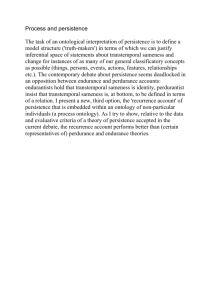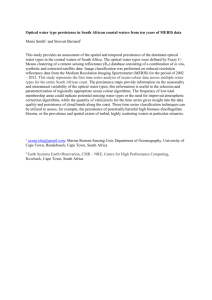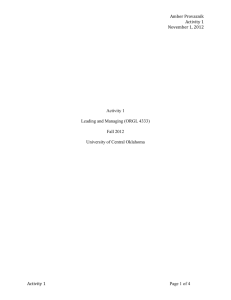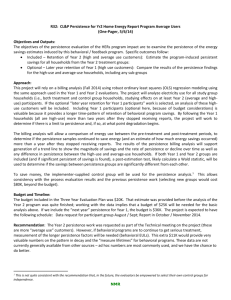Conrad-Aryn-Mariscal-Carlos-2012-Evolution-by
advertisement
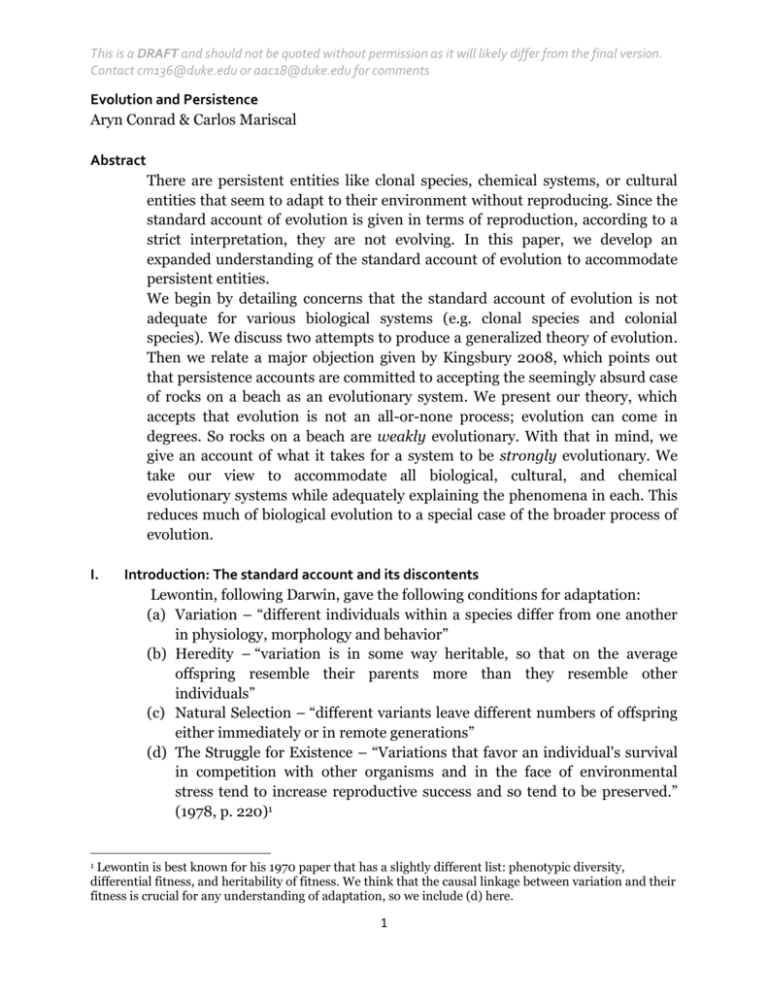
This is a DRAFT and should not be quoted without permission as it will likely differ from the final version. Contact cm136@duke.edu or aac18@duke.edu for comments Evolution and Persistence Aryn Conrad & Carlos Mariscal Abstract There are persistent entities like clonal species, chemical systems, or cultural entities that seem to adapt to their environment without reproducing. Since the standard account of evolution is given in terms of reproduction, according to a strict interpretation, they are not evolving. In this paper, we develop an expanded understanding of the standard account of evolution to accommodate persistent entities. We begin by detailing concerns that the standard account of evolution is not adequate for various biological systems (e.g. clonal species and colonial species). We discuss two attempts to produce a generalized theory of evolution. Then we relate a major objection given by Kingsbury 2008, which points out that persistence accounts are committed to accepting the seemingly absurd case of rocks on a beach as an evolutionary system. We present our theory, which accepts that evolution is not an all-or-none process; evolution can come in degrees. So rocks on a beach are weakly evolutionary. With that in mind, we give an account of what it takes for a system to be strongly evolutionary. We take our view to accommodate all biological, cultural, and chemical evolutionary systems while adequately explaining the phenomena in each. This reduces much of biological evolution to a special case of the broader process of evolution. I. Introduction: The standard account and its discontents Lewontin, following Darwin, gave the following conditions for adaptation: (a) Variation – “different individuals within a species differ from one another in physiology, morphology and behavior” (b) Heredity – “variation is in some way heritable, so that on the average offspring resemble their parents more than they resemble other individuals” (c) Natural Selection – “different variants leave different numbers of offspring either immediately or in remote generations” (d) The Struggle for Existence – “Variations that favor an individual's survival in competition with other organisms and in the face of environmental stress tend to increase reproductive success and so tend to be preserved.” (1978, p. 220)1 Lewontin is best known for his 1970 paper that has a slightly different list: phenotypic diversity, differential fitness, and heritability of fitness. We think that the causal linkage between variation and their fitness is crucial for any understanding of adaptation, so we include (d) here. 1 1 This is a DRAFT and should not be quoted without permission as it will likely differ from the final version. Contact cm136@duke.edu or aac18@duke.edu for comments These conditions are generally regarded as uncontroversial. Notice that according to this account, reproduction is an essential part of evolution by natural selection. By extension, only organisms that reproduce can have adaptations produced by natural selection. Most of the time, the standard account works well for biologists and others who use biological abstractions. Even those who study cultural evolution generally treat cultural variants or memes as reproducing entities. (See Boyd and Richerson, Laland and Brown, Dawkins, and Milikan in LTOBC.) But there are some tricky cases. Section II covers some of these cases. In section III, we discuss Frederic Bouchard’s work, which draws heavily on these tricky cases. Bouchard diagnoses the problem as being overly focused on reproduction rather than survival. If reproduction is understood as merely one of many ways genes or lineages can survive, then a survival-based account of evolution will be more accurate. Bouchard believes his account does this. We also discuss Justin Garson, who also proposes a moderate approach, which allows for persistence and reproduction. Section IV discusses an objection by Justine Kingsbury applies to both Bouchard and Garson’s accounts. Section V presents our view in which we reject the implications that Kingsbury thinks follow from her thought experiment. Instead, we proceed to diagnose what the standard account misses: a more complete interpretation of variation. We take our account to apply to evolutionary systems of any sort, anywhere, not merely biological evolution. We end with plans for future work. II. Tricky Cases For most organisms, the distinction between growth and reproduction is straightforward. Growth is when an organism increases in size, amount, or energy available for expansion. Reproduction is when an individual splits into two or a sequestered germ line goes through a one-cell bottleneck and a new, separate individual is produced. But for some creatures, the distinction between growth and reproduction is not so neat as reproduction is not always the primary means of propagation. Quaking aspen primarily propagate by sending out root stems. From these stems grow individual trees called ramets. The collection of the ramets connected by a root system is called a genet and constitutes one organism. They rarely reproduce via seeds. The oldest stand, Pando, is 80,000 years old. It may not have flowered for over 10,000 years (Einspahr and Winton 1976, Mitton and Grant 1996). Now, consider the following: Two genets, A and B, live in the same environment. For simplicity, they are both female so they cannot mate with each other. One of the ramets in A mutates in a way that allows it to better draw water out of the air. Over time, the environment becomes drier so that both the non-mutated ramets of A and B 2 This is a DRAFT and should not be quoted without permission as it will likely differ from the final version. Contact cm136@duke.edu or aac18@duke.edu for comments eventually die off. But, the mutated portions of A live on. Intuitively, it seems as though A has been selected over B and moreover, that A has done better than B. Indeed, the mutation could be called an adaptation to the drier environment. Strictly speaking, however, this scenario does not fit the standard formulation as no reproduction has taken place. There has only been differential persistence. In this case, selection is acting on parts of a growing individual, not a population of individuals. The case is easier in the cultural realm. Consider what goes on in the case of companies. Companies compete with each other. Some go bankrupt, others thrive, and some just continue scraping by. But rarely do they seem to reproduce. When they do, it is often because they are forced to split. Typically the goal of businesses is not to multiply, but to grow. Perhaps there is some sense in which companies reproduce: after they go bankrupt their ideas, employees, stakeholders, and assets disperse to new companies. But this sort of reproduction is not the sense in which we usually determine a company’s success. Instead, a company’s success is described in terms of profitability, persistence, and influence. The proliferation of a company’s ideas might be of interest to those who study cultural evolution, but it does not seem to be the best way to measure a company’s success. Certainly it is not the way economists conceive of successful companies. Luckily, there are other ways the Darwinian approach can be applied. Consider two companies, R and S, that want to expand into a new market– developing nation Y. They both sell small consumer electronics and are in direct competition. After doing their market research, both companies decide on a plan of action. R markets directly to women, figuring that although Y’s society is patriarchal, women will be the most likely to generate demand. S banks on the patriarchal nature of the nation, and markets to men, trying to appeal to prestige biases. R’s strategy works well and they make good profits. S, on the other hand, goes bankrupt. It seems like a Darwinian perspective is useful here– R was selected over S.2 Moreover, it seems like the marketing strategy was well adapted to the new environment. But it will not fit the standard model as neither R nor S reproduced. R succeeded over S in two ways: it persisted longer and it made more money. But profits are not offspring and persistence is not allowed as a measure of fitness. Companies and aspen are not the only entities left out in the cold by the standard account. Other persistent entities have spurred some to try to reformulate the standard account. In the next section, we will describe two of these accounts and show how they are persistence accounts. Next, we will present problems for The fact that companies designed their strategy is not anti-Darwinian. The only design that is antiDarwinian is the omniscient design of the pre-Darwinian God. This is merely a case in which variation is not blind as in organismic biology, but near sighted (Mesoudi 2006). 2 3 This is a DRAFT and should not be quoted without permission as it will likely differ from the final version. Contact cm136@duke.edu or aac18@duke.edu for comments these accounts. In section V, we present our account, in which we reconsider each of the criteria highlighted by Lewontin. III. Other Persistence Accounts For the past decade, Frédéric Bouchard has challenged the received view of evolution with his own persistence account. He points to cases such as the Quaking Aspen and termite colonies to highlight how the standard account fails to adequately explain cases of adaptation in which no reproduction takes place. Bouchard hones in on the role of fitness, pointing out that some tricky biological cases cannot be satisfactorily accounted for if we define fitness as differential reproductive success. Bouchard instead proposes an account of fitness in terms of survival. His own view is to define fitness as a propensity toward Persistence Thru Time (PTT). His account defines fitness roughly as follows: (Lineage) X is fitter than (lineage) Y if X has a higher propensity to persist for Z amount of time than Y. (2011 p. 16) The PTT account of fitness is intended to fit every case of adaptation. Mitotic cell division of single-celled organisms, sexual reproduction, and unusual cases like the Quaking Aspen are accounted for in terms of their propensity to persist through time. In some cases, the lineage is defined in terms of reproduction, in others persistence and growth is sufficient. Bouchard’s account is of a singular criterion for fitness: growth and development are relevant to fitness just in case they increase the propensity for a lineage to persist. Bouchard’s motivation for a unitary account of fitness seems to be methodological: we should attempt monist approaches before proceeding with the assumption of pluralism. If one assumes that a phenomenon is not unified, the phenomena will remain disparate. Bouchard’s account is radical. Looking back to the list that began this article, Bouchard can be viewed as implying the following reformulation of Lewontin’s original account of adaptation: (a) (b) (c) (d) Variation Heritability (in the form of persistence, presumably) Differential Persistence Through Time (PTT) A Causal Connection between (a) and (c). According to Bouchard, by changing our concerns from reproduction to survival in (c), we can account for all of the relevant cases we mentioned in section II, as well as many more. One virtue of Bouchard’s view is that persistence certainly seems to be the ideal candidate for a unitary conception of fitness. Persistence 4 This is a DRAFT and should not be quoted without permission as it will likely differ from the final version. Contact cm136@duke.edu or aac18@duke.edu for comments seems to be a necessary feature for evolutionary success. If a lineage does not persist, ceteris paribus, then it is not fit. Bouchard is not the only person to propose a persistence-based account of adaptation. Focusing on rather different sets of issues, Justin Garson is interested on the differential retention of some neural connections over others. With an eye on the mental content debate, Garson recommends this reformulation of the Selected Effects account of function: The function of a trait consists in that activity that historically contributed to its being differentially reproduced or differentially retained within a biological system (555). Garson’s Generalized Selected Effects Theory of Function implies the following reformulation of Lewontin’s original account of evolution by natural selection: (a) (b) (c) (d) Variation Heritability Differential Reproductive Success or Retention A Causal Connection between (a) and (c). Garson’s account, because it is tailored to fit neural selection, does not specifically deal with heredity. He must at least accept an account of similarity over time in order for the persistence cases to fit. We will return to this later. A key feature of Garson’s account is the differential persistence of a trait. Without this requirement, the account falls prey to a number of counterexamples. For example, Marc Bedau has an example of a twig floating in a stream that brushes against a rock and creates a backwash that contributes to it remaining pinned against the rock (Bedau 1992). The problem with the twig example is that creating a backwash contributes to its own persistence, yet it doesn’t seem to be an adaptation. But this does not fit Garson’s account because here there is no differential persistence. The twig backwash is not the fitter backwash in a population of backwashes. This new formulation looks promising as well. In the next section we will see that both Bouchard and Garson’s account face serious objections. IV. Objections A formidable objection to both of the previous accounts is mentioned in Kingsbury (2008). Imagine a rocky beach. Some of the rocks on the beach are harder than others. When the waves crash on the beach, the harder rocks are less likely to break up than the others. Eventually, the softer rocks are so broken up they cease to exist. 5 This is a DRAFT and should not be quoted without permission as it will likely differ from the final version. Contact cm136@duke.edu or aac18@duke.edu for comments This situation fits the requirements of both views. For Bouchard’s theory, the harder rocks have a higher propensity to persist through time compared to the softer rocks. Bouchard, however, is not committed to allowing evolution to apply to the realm of the non-living, and can respond by denying non-biological cases. There are two problems with this approach, however. First, biological cases can be constructed to produce this exact same problem. One can imagine a dystopian future composed entirely of infertile, non-growing Quaking Aspens. On Bouchard’s account, the sturdier ramets are expected to survive longest. So Bouchard is committed to saying the sturdiness of the Quaking Aspen is an adaptation, much like the hardness of the rocks. The second problem is that there is nothing explicitly stated in either Bouchard’s account nor the standard account that requires entities to be alive in order to undergo evolution by natural selection. Nor should we be committed to this without consideration. Are viruses, for example, considered alive? They certainly evolve according to the standard account. Prions make the case even murkier. Depending on how Bouchard defines life, he might have to deny that viruses or prions evolve in his account. Bouchard’s theory fits the rocks on the beach case as described by Kingsbury. So, too, does Garson’s theory. The population of rocks on the beach has variation and some kind of historical continuity. They also differentially persist and there is a causal connection between the differential persistence and the relevant variants. That means that the rocks are, on persistence grounds, evolving by natural selection. This also commits views about persistence to the claim that the hardness of the rocks is an adaptation to their environment. This seems highly counterintuitive to many people. Clearly, a good account must either avoid this conclusion or explain how it can be acceptable. We take the latter route. V. Adapting Persistence: Our Account a. A map of our project In this section, we lay out our account of evolution by natural selection. We do not want to reject the standard account- merely expand it. We will keep Garson’s important move: differential persistence is key- mere persistence is not enough. Our account also makes minor modifications to the other Lewontin criteria. We list them here and explain them in the following sections: (a) (b) (c) (d) Populational or Individual Variation Historical Continuity Differential Success3 A Causal Connection between (a) and (c). Persistence will always be a measure of success, but something like differential reproduction or growth will also apply. Consider the case of companies in which success can be measured by profitability as well as persistence. Profitability seems to be a growth-like measure. 3 6 This is a DRAFT and should not be quoted without permission as it will likely differ from the final version. Contact cm136@duke.edu or aac18@duke.edu for comments Notice that we make no changes to (d) and we only make minor changes to (c). In order to solve issues with (c), we must modify (b) to avoid discussing evolution in terms of objects with discrete generations. We use what is a very minimal condition of historical continuity. Evolving individuals like biological species are historically continuous with themselves.4 In many biological cases, this is achieved using discrete generations, but these are special cases–not required for a general evolutionary account. Interestingly, the bulk of the work in our account is done by expanding (a): the notion of variation. We will start by briefly responding to the two objections Bouchard and Garson’s accounts faced. b. Biting bullets: Evolution is a matter of degree Our first move is to bite the bullet on the rocks on the beach example, although perhaps “nibble” is a better word. We think that evolution is a matter of degree. On the evolving end, you have rich evolutionary systems like organisms and culture that produce a strong fit of organisms to their environment. On the minimal end, one can imagine a bunch of Helium atoms in a vacuum. They aren’t evolving in any intuitive sense.5 The rocks on the beach are on the weak end of evolution, but they still count as an evolving system– albeit a boring one. Systems can vary with respect to how much variation occurs, how heritable certain features are, and how much selection is present, not to mention that the environment also varies. So it shouldn’t be surprising that the strength of an evolutionary system should also vary. Something similar to this could have happened early on in the history of life. Perhaps we could say, “In the beginning were the chemicals, and the chemicals persisted differentially.” Replicators might have appeared de novo, but perhaps they did not. To define the possibility out of existence is to beg the question of how life originated. The important point is that whether or not something is evolving is a matter of degree. From systems that are merely weakly evolutionary can come strong evolutionary systems like those we see today. This picture allows for gradualism about many aspects of evolution including selection, adaptation and function. c. Two kinds of variation There are two kinds of variation in a selection process. They are not unrelated, but they are distinct enough that we think of them as two separate spectra on which a given system may vary. That is, a system may be low on one and high on While we have contingent answers to the metaphysical concerns of continuity and persistence, to address these fully would greatly derail the present proposal. 5 Robert Brandon pointed out to us that the Helium atoms are still moving around and are thus varying with respect to position. So in this respect, some very weak, very boring, sort of evolution is possible. 4 7 This is a DRAFT and should not be quoted without permission as it will likely differ from the final version. Contact cm136@duke.edu or aac18@duke.edu for comments the other or vice versa, even if it is hard to find a good instance of one being entirely absent. One is at the level of populations and the other is at the level of individuals. i. Fresh Populational Variation One kind of variability displayed by strong evolutionary systems is the capacity for fresh variants to enter the population. Consider the rocks on the beach. New individuals may enter the beach– that is, new rocks may be delivered by streams or lava flows, but these rocks are not more likely to be adapted to the beach than the rocks that came before them. The population of rocks will not increase in diversity as a result of these new rocks. On the other hand, new variants can enter a population of vertebrates via immigration, mutation, recombination, and plain old sexual reproduction, among other things. Evolution cannot create anything new in the case of the rocks, but it can in the case of organisms. ii. Individual Mutability Like rocks, vertebrates cannot vary themselves as individuals, at least not much. The majority of the variation is seen in their offspring. But some things can change themselves internally. For example, companies can. One of our favorite examples is that of Nintendo, which started out as a playing card company in 1889 and now makes video games and consoles. Companies are an example of individuals that are highly mutable. Similarly, biological lineages can be mutable as well. Consider DNA as conceived of by Dawkins- this is a lineage that persists as a historical entity. As a lineage, it displays a high degree of mutability. However, if it is conceived of in this way, there is a sense in which it is not truly a reproducer, but a persister. The lineage that is DNA persists through the organisms that contain it. Reproduction is merely a way in which it persists and spreads. This may sound familiar to philosophers. It is related to the type/token distinction. The entities in a lineage are a sort of token, and lineages are a special sort of type. Both of them are historical in nature. Notice that this requires a change to the heredity condition. Individuals that persist do not display heredity, as conceived of in terms of discrete generations, but they do display historical continuity. Lineages that reproduce also display historical continuity. Table 1 High mutability High Fresh Companies variation DNA Biological Lineages Low Fresh 100 proteins variation 8 Low mutability Paintings Individual vertebrates Rocks Helium atoms in a vacuum This is a DRAFT and should not be quoted without permission as it will likely differ from the final version. Contact cm136@duke.edu or aac18@duke.edu for comments iii. The interrelationship The two kinds of variation just described are interrelated. Philosophers committed to treating populations as historical individuals might even say they describe similar phenomena at different levels. Together, these kinds of variation are exhaustive but not exclusive. The two kinds of variation are related because almost any degree of individual mutability allows for fresh variants to enter the population. Any pure examples using only one kind of variation therefore tend to sound very contrived. Here are our best two attempts: 1. Paintings New paintings constantly enter the population of paintings, but few paintings change in makeup over time. Nevertheless, it is difficult to deny that the paintings have changed over time and that new paintings are typically influenced by the work that came before them. Thus, the paintings throughout history are high on the fresh variation spectrum but low on the mutability spectrum. 2. 100 protein conformations Consider a population of highly mutable proteins that can be in any one of 100 conformations at a time, but cannot change beyond that. This is a population of highly mutable entities but allows for no fresh variants. Once the population has explored all of the 100 conformations, any change in conformation will not be new to the population. This example is more contrived than the first one. That is because mutability leads almost inevitably to new variants entering a population. However, you can have new variants enter a population without any of the constituent entities being mutable. The paintings example is meant to illustrate that. Notice that both of these populations can evolve. Both selection and drift can act within them. The population of paintings can and has evolved over time. Within the example of proteins, the frequencies of conformations can change. One conformation could even go to fixation. But beyond this, there is little room for evolution. This illustrates the primacy of fresh populational variation for strong (or rich) evolutionary systems. Individual mutability is important, but it is important primarily because it introduces new variation into the population. d. More likely to succeed We want to say a brief word about how the concept of fitness changes on our account. Since reproductive success is not always an option for the entities we are considering, we would like to present the following account: 9 This is a DRAFT and should not be quoted without permission as it will likely differ from the final version. Contact cm136@duke.edu or aac18@duke.edu for comments Fitness: A is fitter than B in E iff A is more likely to succeed than B in E. There are many different measures of success. The answers to questions about these will always be objective. Which ones are interesting is determined by the scope of the discipline being used to study them. However, persistence is almost always a measure of success for any persister—not so much for reproducers. For them, the success is reproductive Figure 1 success. But notice that our account helps explain why surrogates for fitness–like caloric intake and so forth, can be good measures. Consider the two grasses in Figure 1. At t1, they cover the same amount of ground. At t2, grass A has expanded to cover much of the world, but grass B remains about the same. However, at t3, grass A has gone extinct. Grass B remains, and persists for a very long time. There seems to be a sense in which A was more successful than B, and another sense in which B was more successful than A. We could substitute trilobites for A and horseshoe crabs for B, using the same intuition. Persistence is one kind of success, but it is not the only one. Another possible substitution is companies. Consider two companies. One makes a spectacular amount of money, but goes bankrupt. The other goes along, sure and steady. There are different kinds of success here. Persistence is one, but once again, it’s not the only game in town. With companies, profitability is very important. Investors and economists care more about this than mere persistence. Other systems might show other kinds of success. VI. Future applications and unresolved questions a. Drift We think persistent entities can evolve by drift, but at this point have not yet worked out how that is. Initially, we want to say that cases of drift will fulfill a-c, but d will be absent. We suspect that all evolutionary systems will tend to drift (Brandon 2006). b. Metaphysics As stated earlier, there are many metaphysical issues that arise in this discussion. We recognize that there is a crucial persistence question left unresolved here. Our account is about evolution and should be consistent with many possible metaphysical views. Given the space and time constraints for this draft, we are unable to discuss them here. We hope to address these in future work. 10 This is a DRAFT and should not be quoted without permission as it will likely differ from the final version. Contact cm136@duke.edu or aac18@duke.edu for comments c. Mathematics Despite our most sincere efforts, neither of us is R.A. Fisher. We have not yet worked out a population genetics for evolutionary systems that don’t have populations. That said, the math would likely vary with each system. For most of biology, mutation at the genetic level is the ultimate source of variation. It is relatively straightforward to describe mathematics for evolutionary systems given only one possibility of fresh variation. We expect the mathematics behind evolutionary systems with significantly different forms of variation will be far more complex. d. Workability We expect a major challenge to our view will be that it is not useful to working biologists. This may be true for most, but it is not true for those working on certain areas of biology. For example, a huge question facing biologists is the origins of life. How do you get from non-living to living? Liane Gabora (2006) argues that early life did not evolve through natural selection because the standard account does not allow for the inheritance of acquired characteristics (as some models of the origins of life hold). In our account, that is not a problem– both chemical evolution via enclosed autocatalytic sets and biological evolution via replication are forms of evolution. Our account will also be useful for people interested in cultural evolution, as we have described. In the past 30 years, evolutionary approaches to economics have become more widespread. If evolutionary theory only applies to reproducing entities, it is unclear whether evolution can explain anything in economics. Using our account, however, seeing economic adaptations can be more straightforward. VII. Conclusion The possibility of an evolutionary account for persistent entities has remained an unsolved issue in cultural evolution and we argue that it is problematic in regular biology as well. Here, we have presented an account of evolution that applies to persistent entities as well as reproductive ones. Our account allows for degrees of evolution. As such, we accept Kingsbury’s case of differential persistence of rocks on a beach as weakly evolutionary. Biology should teach us to expect gradation and change everywhere. We’re not sure why this approach isn’t championed more often. With that in place, we describe our view opposite the views of Bouchard and Garson’s. We elaborate on the role of heritability and variation far more than either. Understanding these elements makes us reconsider what is doing the evolving– the population or the lineage to which the population evolves? We accept the latter because it makes sense of evolution anywhere it takes place. 11 This is a DRAFT and should not be quoted without permission as it will likely differ from the final version. Contact cm136@duke.edu or aac18@duke.edu for comments References 12

